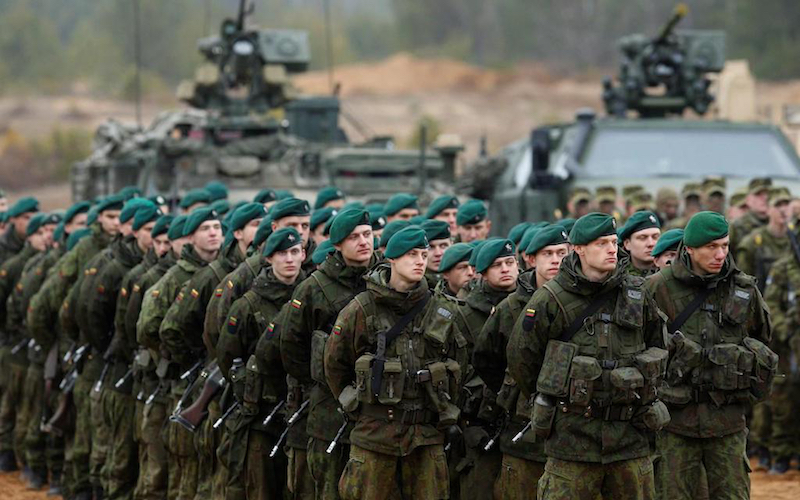
Lithuania’s Tug of War with Russia Just Got Serious
While Ukrainian Armed Forces continue to suffer setbacks against rebels in the Eastern part of the nation, policymakers and regional analysts are asking serious questions about Russia’s involvement, next move, and its ultimate endgame. Regionally, the current situation has forced neighboring countries, among them the Baltic states, to reconsider their strategic posture towards Moscow. Particularly, in Lithuania, the government is now discussing the implementation of tangible measures to ensure a similar conflict does not arise within its borders.
For Lithuanians, Russia’s aggressive maneuvers for Crimea are reminiscent of 1940, when the USSR invaded Lithuania, Estonia, and Latvia. Nazi Germany and Operation Barbarossa interrupted the occupation; however, it was only a temporary state of affairs as the Soviet forces returned in 1944. After dominating the states militarily, the Kremlin pulled the strings of the political scene, entrenching regimes that were de facto puppets of the Kremlin and members of the USSR.
The ghosts of the past still haunt political leaders in the region. Baltic states, including Lithuania, serve as a region where NATO and Russian forces could come in direct military contact.
In preparation for any possible tensions and armed action, Vilnius is already taking steps to deter and respond to any military aggregation from Russia. Perhaps, in a move that is more saber rattling than a true call to arms, Lithuanian President Dalia Grybauskaite has reinstated the draft to fill the ranks of their relatively small military of some 16,000 servicemen.
The events in Ukraine are not an isolated incident of provocative Russian actions. Over the past few years, the Russian military has become bolder in asserting its regional dominance and is increasingly demonstrative in its show of military reach. The European Leaders Network recently reported that Russian provocations have increased in frequency and intensity against Baltic states. Specifically, in response to Russian actions, the NATO Air Policing Mission has conducted at least 68 “identification and interdiction missions along the Lithuanian border alone.”
But why would Russia stand to win by mounting a hybrid war with any Baltic state? The answer lies in the Kaliningrad strategic enclave and cold war remnant. Cutoff from the Russian mainland by Lithuania, the oblast is a policymaker’s nightmare: poverty, unemployment are completely incapable of ensuring its economic viability. Kaliningrad serves solely as Moscow’s forward position in Europe. Since Putin became president, the region has been placed in a state of constant military readiness. Moreover, for 2015, the Russian Defense Ministry plans to modernize and bolster the armed forces deployed in Kaliningrad. There are fears that the Kremlin could try to carve out a land corridor through Lithuania and link the oblast to Russia.
Fortunately, unlike Ukraine, Lithuania is a full-fledged member of NATO, granting them full-rights under the protocols of the NATO Charter, including protection under the concept of collective defense. NATO, to its credit, has clearly reaffirmed its dedication to this concept.
During a visit to Estonia in September, President Obama proclaimed “…we will defend our NATO allies, and that means every ally. In this alliance there are no old members or new members, no junior partners or senior partners. They’re just allies, pure and simple, and we will defend the territorial integrity of every single ally.”
Obama continued, “today more NATO aircraft patrol the skies of the Baltics. More American forces are on the ground training and rotating through each of the Baltic states. More NATO ships patrol the [Baltic] Sea.” Strong statements like these not only assure Baltic allies of the alliance’s commitment to military action, but serve as a warning to Russia that NATO intends to defend its members.
NATO allies have also proven willing to show their military strength in the Baltic region, holding a large military exercise, Operation Iron Sword 2014, in the forests of Lithuania. The exercise featured approximately 2,500 soldiers from the US, the UK, Canada, the Czech Republic, Estonia, Germany, Hungary, Lithuania, and Luxembourg. The exercise included improvised ground and air defense maneuvers.
For Lithuania and the other Baltic states, pressure does not have to come in the sole form of Russian military maneuvers and occupation, but could also be manifested through energy politics. 100% of Lithuania natural gas flows from or through Russia. Lithuanian officials are aware of the implications of this energy dependency on the sovereignty and security of the nation, arguing that they will never be truly independent of Russia until they achieve energy self-sufficiency. To this end, the Baltic states have tabled the idea of nuclear facilities that should serve the energy needs of a Pan-Baltic energy union. This is in addition to the recent opening of a new LNG terminal in Lithuania at the seaport of Klaipeda, whose annual capacity of 4 bcm could free Lithuania from its dependence on Gazprom.
Compared to Ukraine and other Baltic states, Lithuania has a much smaller and less influential Russian-speaking minority at 6.8% of the population. What’s more, the Russian minority has shown little interest in the separatist movement in Ukraine.
In the near future, the fighting will continue to rage in Ukraine and NATO will continue to demonstrate its regional might and commitment to its Baltic members. NATO will also continue to draw lines in the sand and Russia will continue to test these lines. In the long run, Vilnius will look towards a future where it does not depend on the sociopolitical and economic proclivities of the Kremlin. Time will tell if the current tense state of affairs will become the new normal in the Baltic region.

